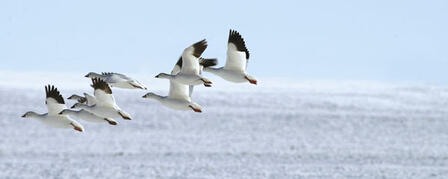LATE WINTER HUNTERS GET THE GOOSE

Many areas still reporting good numbers of geese; snow geese may be taken through April 30
PRATT — Although reports of winter geese numbers in Kansas are down from this time last year, good numbers may still be found by the intrepid hunter willing to brave winter cold. Most geese remaining in the Sunflower State are snows although Canada geese and a few white-fronted geese may be found in some areas. Best times to hunt are morning and evening, when geese may be found feeding in cut grain fields and may readily flock to an array of decoys. Waiting for giant flocks of geese to leave their daytime resting spots and fly above the landscape to feed can be exhilarating, and when the hunting is good, the harvest makes fine winter table fare.
As of Feb. 1, the reported number of geese in Kansas was approximately 135,000, but those numbers vary greatly. Currently, the top areas for geese are ; Glen Elder Wildlife Area (WA) with 20,000; Elk City WA with 12-15,000; Norton WA with 10,000; Cedar Bluff WA with 10,000; Neosho WA with 7,200; and Cheyenne Bottoms WA with 6,000. These numbers are approximate and can greatly from day to day, so it's good to check the nearest Kansas Department of Wildlife and Parks (KDWP) office for the latest information. Updated waterfowl reports may also be found on the KDWP website, www.kdwp.state.ks.us.
Canada goose season runs through Feb. 13 statewide. The remaining white-fronted goose season runs Feb. 5-13. Light geese (Ross', snow, and blue) may be hunted through April 30.
All waterfowl hunters 16 and older must have a federal Migratory Bird Hunting and Conservation Stamp, and all hunters who are required to obtain a license must also have a Kansas State Waterfowl Habitat Stamp and a Harvest Information Program (HIP) stamp before attempting to take ducks and geese. (Those not required to have a Kansas hunting license include people hunting their own land and residents 15 and younger or 65 and older.) Hunters are reminded that a valid 2011 hunting license is required, unless exempt.
Waterfowl and HIP stamps purchased during the fall 2010 seasons are valid through the winter and spring of 2011.
-30-









